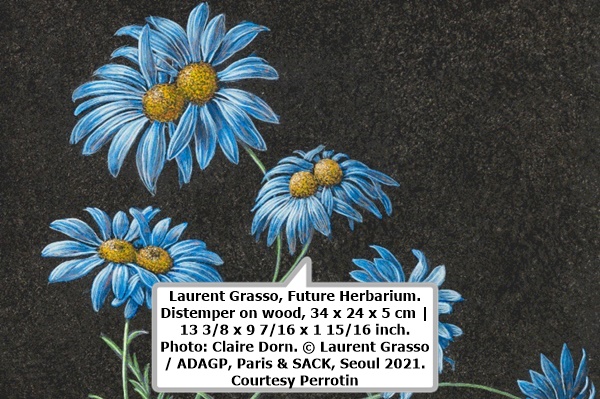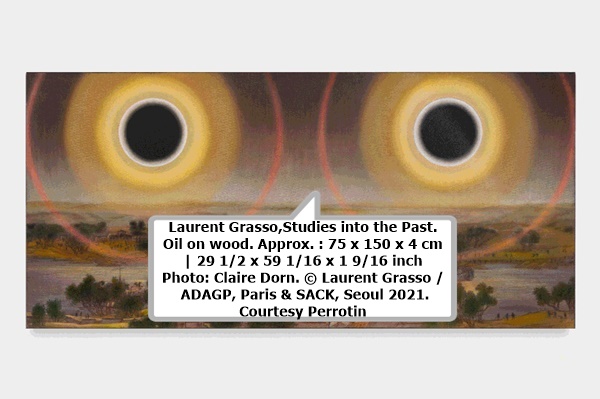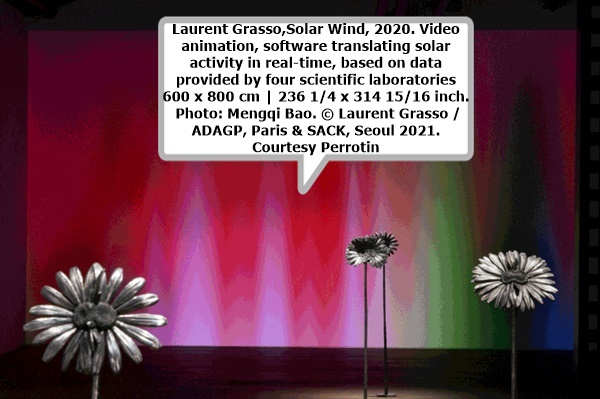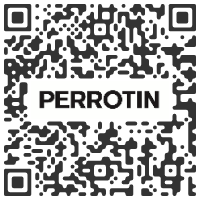"Future Herbarium"
Laurent Grasso

PERROTIN
8/F, K11 ATELIER VICTORIA DOCKSIDE, 18 SALISBURY ROAD, TSIM SHA TSUI, HONG KONGT: +852 3758 2180 / F: +852 3758 2186 e-mail:
Multiple location : Shanghai New York Paris(3) Hong Kong Tokyo Seoul



March 20 > April 24, 2021



Perrotin Hong Kong is pleased to present Future Herbarium by renowned French artist Laurent Grasso, whose practice is concerned with heterogeneous temporalities, geographies, and paranormal phenomena, and spurring a new perspective on history and reality by materializing what lies behind common perception.
Perrotin Hong Kong is pleased to present Future Herbarium by renowned French artist Laurent Grasso, whose practice is concerned with heterogeneous temporalities, geographies, and paranormal phenomena, and spurring a new perspective on history and reality by materializing what lies behind common perception.
The exhibition, Grasso’s first solo presentation with Perrotin in Hong Kong, is titled after his latest investigation into the idea of exploring the contemporary world anew. Key to these ongoing studies is his recently debuted film Artificialis, which was produced in collaboration with the Musée d’Orsay. Film has been a core medium in Grasso’s artmaking employing overhead camera shoots and various technologies and instruments to reveal things invisible to the human eye. His first encounter with Hong Kong 18 years ago culminated in one of his earliest films to be shot aerially on a helicopter flyover (Radio Ghost, 2003). Artificialis is Grasso’s first film to be made up entirely of treated footage
In 2017, the museum commissioned Grasso to create a large-scale work in dialogue with its exhibition, The Origins of the World: The Invention of Nature in the 19th Century. Using Darwin’s theory of evolution and On the Origin of Species as a point of departure, Grasso, together with his studio, engaged in an in-depth, three-year examination into the development, mutation and transformation of the natural world, researching the irremediable alteration of nature by humankind, and the intertwining of the natural and cultural worlds. Grasso concentrated on examining spaces and phenomena in which the boundary between nature and culture has become indistinguishable in a post-Anthropocene era. He proposes a reconsideration of our uncertain contemporary era through the prism of the nineteenth century, which was defined by the interweaving of beliefs and science, the emergence of Darwin’s theories, and architectural engineering of monumental structures such as the future Musée d’Orsay.
From this immense survey, Grasso composed Artificialis, an intricate collage of moving images and visualizations depicting scenes of expeditions and engineering ventures that blur the distinction between the natural and the artificial. In making the film, Grasso and his studio, assisted by a scientific team, undertook an extensive process of selecting and modifying existing footage (some of which had been captured through LiDAR scanners), facts, and narratives from a diverse array of sources. Artificialis, as envisioned by Grasso, “questions the notion of exploration through new tools, and reveals an invisible world, to which we had no access until now. It shows an ambiguous, spectral territory in full mutation, where reality and virtuality overlay, and where the landmarks are totally dissolved.”
In parallel to Artificialis, Grasso developed Future Herbarium, a body of painted and sculpted flowers executed in the manner of nineteenthcentury herbariums, shaped by observations of different species of flowers that mutated after the Fukushima disaster in Japan. Some of Grasso’s conjoined flowers are rendered as casted bronze and carved marble sculptures, suggesting fossilized forms of his painted specimens.
One room in the exhibition is dedicated to works from this new series. A second room features new works from Grasso’s emblematic series, Studies into the Past, which he initiated in 2009, reconstituting methods and imagery used by the Italian and Flemish masters of the fifteenth and sixteenth centuries such as Andrea Mantegna and Hans Memling. The mythological and religious narrative elements characteristic of the Renaissance, however, are replaced by celestial phenomena rarely illustrated before the nineteenth century, such as eclipses, auroras borealis, and meteorites. The insertion of fragments of the future into paintings seemingly from the past breaks the chapters in the history of painting. Manipulation of historicity permeates Grasso’s works. By modifying their relationship to time, integrating motifs borrowed from other cultures, and adding geographical confusion to the mix of temporalities, he creates what he calls a “false historical memory”, challenging the boundaries of what we perceive and know.
Grasso’s voluminous research includes an interest in Chinese folk beliefs, mythology, and cultural narratives. In particular, some of his works exhibited in this room were influenced by paintings of Italian Jesuit Giuseppe Castiglione (1688–1766), also known as Lang Shining in Chinese, who for most of his life served as an official portraitist for the imperial court through the reign of three Qing emperors. Castiglione’s paintings not only provide valuable insight into life in the Forbidden City; they are distinguished for his impeccable hybridization of Chinese subjects and aesthetics, and Renaissance techniques based on the emphasis on perspective and realism.
Serving as the epilogue of the exhibition is Grasso’s video installation Solar Wind, also presented at the new Jeonnam Museum of Art, South Solar Wind, 2020. Video animation, software translating solar activity in real-time, based on data provided by four scientific laboratories 600 x 800 cm | 236 1/4 x 314 15/16 inch. Photo: Mengqi Bao. © Laurent Grasso / ADAGP, Paris & SACK, Seoul 2021. Courtesy Perrotin Korea, for its inauguration in March. It articulates concepts of science, belief, illusion and fiction, based on his interest in solar storms and space meteorology. Grasso worked closely with the CNES (France National Centre for Space Studies), which collects data on solar activities from various laboratories, to devise an algorithm precise enough to react in real time to transmitted data. Fluctuations in the solar data are visually translated into light waves with the assistance of a team of optical engineers. The original verson of Solar Wind (2016) is a permanent public installation, its constantly morphing colors projected onto the walls of the concrete silos at Calcia’s cement manufacturing distribution center in Paris.
The iteration in the exhibition features sound effects generated by the same algorithm. As Grasso explains, “I designed the project around my interest in theories about the sun. Solar Wind, shown on a LED screen, and as a site-specific projection, is an object that shines on the other works. Thus, the project relates solar rays emitted through the video onto the herbarium, as if they were exposed to these rays.” In 1989, millions of people were plunged into darkness after geomagnetic disturbances caused by a solar storm knocked out electricity in the Canadian province of Quebec. Solar Wind hints at this unknown power beyond human control. Following the path of solar activity in real time, the light waves wander and linger around the room, while hundreds of millions of light years away, modern fears that are inseparable from human destiny are growing.
Laurent Grasso (b.1972) lives and works in Paris (France) and New York (USA). His work addresses different scales and temporalities across multiple media. He has questioned the structure of the museum, the history of art, themes of nature and culture, as well as notions of science and technology. Major exhibitions include: Gakona, Palais de Tokyo, Paris, 2009; Black Box, Hirshhorn Museum and Sculpture Garden, Washington, D.C., 2011; Uraniborg, Jeu de Paume, Paris, 2012; Musée d’Art Contemporain, Montreal, 2013; Soleil Noir, Fondation Hermès, Tokyo, 2015; PARAMUSEUM, Palais Fesch, Musée des Beaux-Arts, Ajaccio, 2016; OttO, Biennale of Sydney, 2018; and Perrotin, Paris, 2018. From March 22 through August 8, 2021, a selection of works from his new series Future Herbarium, and his films OttO (2018) More information ,Soleil Noir (2014) and Solar Wind (2020), will be featured in the inaugural exhibition of The Jeonnam Museum of Art, Gwangyang, South Korea. Soleil Noir(2014)Solar Wind(2020) Grasso was awarded the Prix Marcel-Duchamp (2008), and was a resident of the French Academy in Rome - Villa Medici (2004-2005). He was commissioned to create Solar Wind (2016), a permanent public installation projected onto the walls of the Calcia silos located on the outskirts of the thirteenth arrondissement in Paris
Perrotin Hong Kong is pleased to present Future Herbarium by renowned French artist Laurent Grasso, whose practice is concerned with heterogeneous temporalities, geographies, and paranormal phenomena, and spurring a new perspective on history and reality by materializing what lies behind common perception.
The exhibition, Grasso’s first solo presentation with Perrotin in Hong Kong, is titled after his latest investigation into the idea of exploring the contemporary world anew. Key to these ongoing studies is his recently debuted film Artificialis, which was produced in collaboration with the Musée d’Orsay. Film has been a core medium in Grasso’s artmaking employing overhead camera shoots and various technologies and instruments to reveal things invisible to the human eye. His first encounter with Hong Kong 18 years ago culminated in one of his earliest films to be shot aerially on a helicopter flyover (Radio Ghost, 2003). Artificialis is Grasso’s first film to be made up entirely of treated footage
In 2017, the museum commissioned Grasso to create a large-scale work in dialogue with its exhibition, The Origins of the World: The Invention of Nature in the 19th Century. Using Darwin’s theory of evolution and On the Origin of Species as a point of departure, Grasso, together with his studio, engaged in an in-depth, three-year examination into the development, mutation and transformation of the natural world, researching the irremediable alteration of nature by humankind, and the intertwining of the natural and cultural worlds. Grasso concentrated on examining spaces and phenomena in which the boundary between nature and culture has become indistinguishable in a post-Anthropocene era. He proposes a reconsideration of our uncertain contemporary era through the prism of the nineteenth century, which was defined by the interweaving of beliefs and science, the emergence of Darwin’s theories, and architectural engineering of monumental structures such as the future Musée d’Orsay.
From this immense survey, Grasso composed Artificialis, an intricate collage of moving images and visualizations depicting scenes of expeditions and engineering ventures that blur the distinction between the natural and the artificial. In making the film, Grasso and his studio, assisted by a scientific team, undertook an extensive process of selecting and modifying existing footage (some of which had been captured through LiDAR scanners), facts, and narratives from a diverse array of sources. Artificialis, as envisioned by Grasso, “questions the notion of exploration through new tools, and reveals an invisible world, to which we had no access until now. It shows an ambiguous, spectral territory in full mutation, where reality and virtuality overlay, and where the landmarks are totally dissolved.”
In parallel to Artificialis, Grasso developed Future Herbarium, a body of painted and sculpted flowers executed in the manner of nineteenthcentury herbariums, shaped by observations of different species of flowers that mutated after the Fukushima disaster in Japan. Some of Grasso’s conjoined flowers are rendered as casted bronze and carved marble sculptures, suggesting fossilized forms of his painted specimens.
One room in the exhibition is dedicated to works from this new series. A second room features new works from Grasso’s emblematic series, Studies into the Past, which he initiated in 2009, reconstituting methods and imagery used by the Italian and Flemish masters of the fifteenth and sixteenth centuries such as Andrea Mantegna and Hans Memling. The mythological and religious narrative elements characteristic of the Renaissance, however, are replaced by celestial phenomena rarely illustrated before the nineteenth century, such as eclipses, auroras borealis, and meteorites. The insertion of fragments of the future into paintings seemingly from the past breaks the chapters in the history of painting. Manipulation of historicity permeates Grasso’s works. By modifying their relationship to time, integrating motifs borrowed from other cultures, and adding geographical confusion to the mix of temporalities, he creates what he calls a “false historical memory”, challenging the boundaries of what we perceive and know.
Grasso’s voluminous research includes an interest in Chinese folk beliefs, mythology, and cultural narratives. In particular, some of his works exhibited in this room were influenced by paintings of Italian Jesuit Giuseppe Castiglione (1688–1766), also known as Lang Shining in Chinese, who for most of his life served as an official portraitist for the imperial court through the reign of three Qing emperors. Castiglione’s paintings not only provide valuable insight into life in the Forbidden City; they are distinguished for his impeccable hybridization of Chinese subjects and aesthetics, and Renaissance techniques based on the emphasis on perspective and realism.
Serving as the epilogue of the exhibition is Grasso’s video installation Solar Wind, also presented at the new Jeonnam Museum of Art, South Solar Wind, 2020. Video animation, software translating solar activity in real-time, based on data provided by four scientific laboratories 600 x 800 cm | 236 1/4 x 314 15/16 inch. Photo: Mengqi Bao. © Laurent Grasso / ADAGP, Paris & SACK, Seoul 2021. Courtesy Perrotin Korea, for its inauguration in March. It articulates concepts of science, belief, illusion and fiction, based on his interest in solar storms and space meteorology. Grasso worked closely with the CNES (France National Centre for Space Studies), which collects data on solar activities from various laboratories, to devise an algorithm precise enough to react in real time to transmitted data. Fluctuations in the solar data are visually translated into light waves with the assistance of a team of optical engineers. The original verson of Solar Wind (2016) is a permanent public installation, its constantly morphing colors projected onto the walls of the concrete silos at Calcia’s cement manufacturing distribution center in Paris.
The iteration in the exhibition features sound effects generated by the same algorithm. As Grasso explains, “I designed the project around my interest in theories about the sun. Solar Wind, shown on a LED screen, and as a site-specific projection, is an object that shines on the other works. Thus, the project relates solar rays emitted through the video onto the herbarium, as if they were exposed to these rays.” In 1989, millions of people were plunged into darkness after geomagnetic disturbances caused by a solar storm knocked out electricity in the Canadian province of Quebec. Solar Wind hints at this unknown power beyond human control. Following the path of solar activity in real time, the light waves wander and linger around the room, while hundreds of millions of light years away, modern fears that are inseparable from human destiny are growing.
Laurent Grasso (b.1972) lives and works in Paris (France) and New York (USA). His work addresses different scales and temporalities across multiple media. He has questioned the structure of the museum, the history of art, themes of nature and culture, as well as notions of science and technology. Major exhibitions include: Gakona, Palais de Tokyo, Paris, 2009; Black Box, Hirshhorn Museum and Sculpture Garden, Washington, D.C., 2011; Uraniborg, Jeu de Paume, Paris, 2012; Musée d’Art Contemporain, Montreal, 2013; Soleil Noir, Fondation Hermès, Tokyo, 2015; PARAMUSEUM, Palais Fesch, Musée des Beaux-Arts, Ajaccio, 2016; OttO, Biennale of Sydney, 2018; and Perrotin, Paris, 2018. From March 22 through August 8, 2021, a selection of works from his new series Future Herbarium, and his films OttO (2018) More information ,Soleil Noir (2014) and Solar Wind (2020), will be featured in the inaugural exhibition of The Jeonnam Museum of Art, Gwangyang, South Korea. Soleil Noir(2014)Solar Wind(2020) Grasso was awarded the Prix Marcel-Duchamp (2008), and was a resident of the French Academy in Rome - Villa Medici (2004-2005). He was commissioned to create Solar Wind (2016), a permanent public installation projected onto the walls of the Calcia silos located on the outskirts of the thirteenth arrondissement in Paris
 |
Laurent Grasso |
mpefm
HONG KONG art press release
Opening Hours:
Tuesday to Saturday, 11am – 7pm
In light of social distancing, it is encouraged to schedule your visits in advance here.
Visitors are required to register at the concierge to enter the building.

Opening Hours:
Tuesday to Saturday, 11am – 7pm
In light of social distancing, it is encouraged to schedule your visits in advance here.
Visitors are required to register at the concierge to enter the building.
QR of this press release
in your phone, tablet








